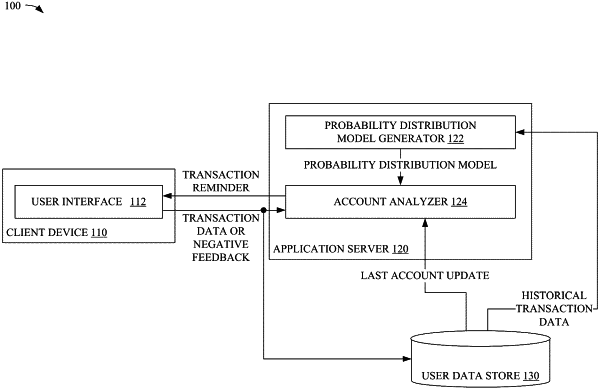| CPC G06Q 40/128 (2013.12) [G06F 17/18 (2013.01); G06Q 40/02 (2013.01); H04L 67/306 (2013.01)] | 21 Claims |

|
1. A computer-implemented method for generating a user interface prompt to perform an action in a software application, comprising:
determining, by an application server, for an account on the application server accessed by a client device, whether a sufficient number of records exist in the account for generating a probability distribution model based on historical transaction time gap data for the account;
generating historical transaction time gap data for transactions in the account, the historical transaction time gap data comprising a data set of elapsed times between each successive transaction in the account;
determining that there is not a sufficient number of records existing for the account;
based on determining that there is not the sufficient number of records existing for the account:
identifying, by the application server, similar accounts on the application server using semantic similarity:
retrieving, by the application server, transaction data for the similar accounts; and
adding, by the application server, additional historical transaction time gap data determined from the retrieved transaction data to the historical transaction time gap data for the account;
generating a probability distribution model based on the historical transaction time gap data, the probability distribution model representing a distribution of probabilities that a new transaction has been performed after an elapsed time from a previous transaction, wherein the probability distribution model comprises a model trained based on an inverted stepwise survival analysis of the historical transaction time gap data such that an inverse of a survival rate indicates a probability that unrecorded transactions exist for the account, wherein the inverted stepwise survival analysis comprises a Kaplan-Meier estimation over multiples of a base time period smoothed based on a Weibull distribution;
determining, based on the probability distribution model and a difference between a time associated with a most recent transaction in the account and a current time, a probability that an unrecorded transaction exists for the account;
determining that the probability that an unrecorded transaction exists for the account exceeds a threshold probability;
receiving from the client device, an indication whether the unrecorded transaction exists;
adjusting the probability distribution model based on the indication received;
generating a prompt to enter new transactions for the account including one or more user interface elements based on determining that the probability that an unrecorded transaction exists for the account exceeds the threshold probability;
automatically creating a record associated with the unrecorded transaction, the record including predicted data for the unrecorded transaction, based on determining that the probability that the unrecorded transaction exists for the account exceeds the threshold probability; and
transmitting the generated prompt to the client device.
|